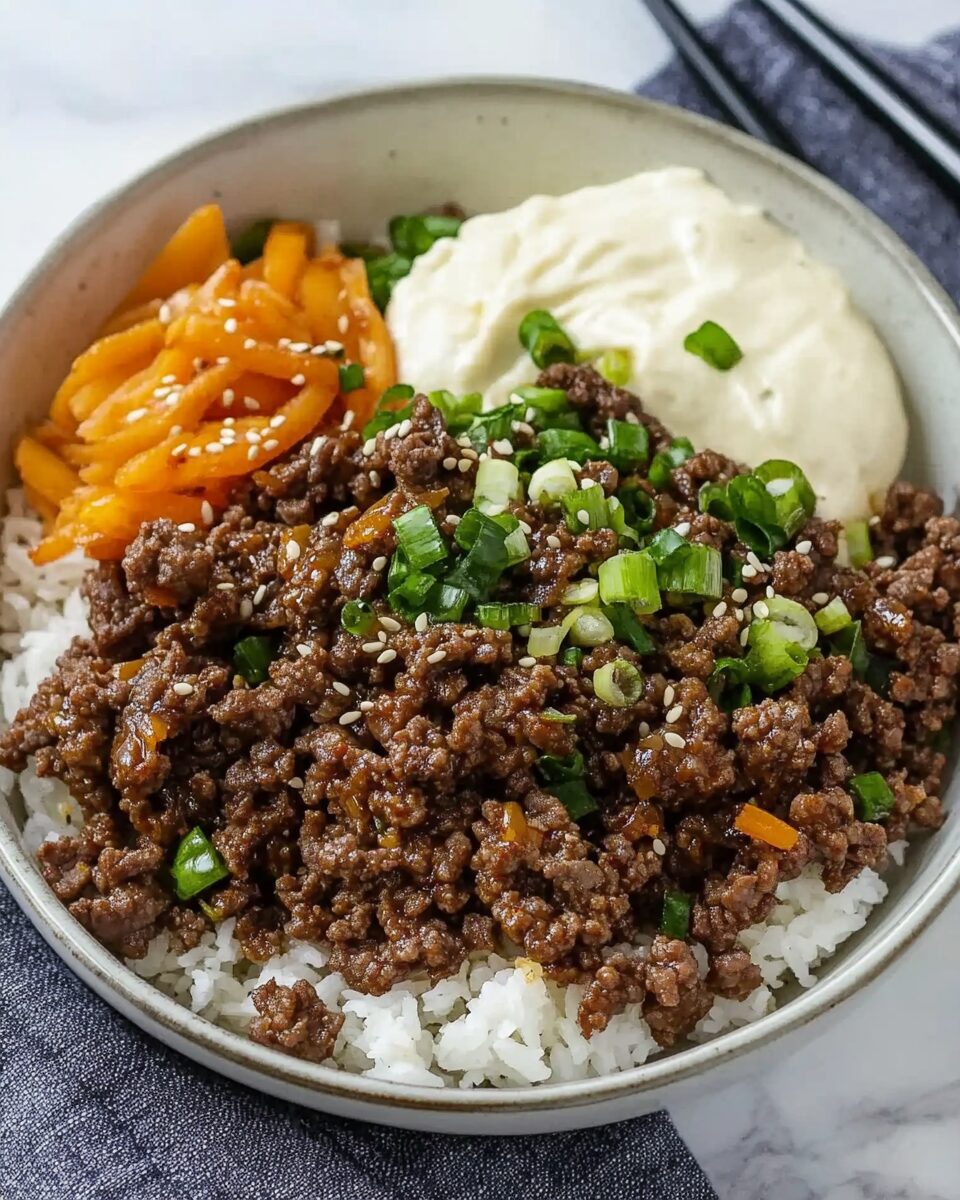Beef Bulgogi is a classic Korean dish that brings together tender marinated beef with a savory, slightly sweet, and smoky flavor profile. The name “bulgogi” translates to “fire meat,” and the dish is traditionally grilled or stir-fried. This flavorful recipe showcases the best of Korean cuisine with its delicious marinade that combines soy sauce, garlic, sesame oil, and brown sugar. Perfect for a family dinner or special occasion, Beef Bulgogi can be served with steamed rice, lettuce wraps, or a variety of other accompaniments.
Full Recipe:
Ingredients:
- 1 pound beef sirloin or rib-eye, thinly sliced
- 1/4 cup soy sauce
- 2 tablespoons brown sugar
- 1 tablespoon sesame oil
- 2 tablespoons rice vinegar
- 2 cloves garlic, minced
- 1 tablespoon fresh ginger, grated
- 1 tablespoon sesame seeds
- 2 green onions, chopped (for garnish)
- 1 tablespoon vegetable oil (for cooking)
Directions:
-
In a bowl, whisk together the soy sauce, brown sugar, sesame oil, rice vinegar, minced garlic, grated ginger, and sesame seeds.
-
Add the thinly sliced beef to the marinade, tossing to coat. Allow it to marinate in the refrigerator for at least 30 minutes, or up to 2 hours for deeper flavor.
-
Heat the vegetable oil in a large skillet or wok over medium-high heat.
-
Once the oil is hot, add the marinated beef in a single layer. Cook for 3-5 minutes, stirring occasionally, until the beef is cooked through and lightly browned.
-
Garnish with chopped green onions and serve with rice, lettuce wraps, or your choice of side dishes.
Nutrients:
- Calories: 320 kcal
- Protein: 27g
- Carbohydrates: 13g
- Fat: 19g
- Fiber: 1g
- Sugar: 10g
- Sodium: 700mg
The History of Bulgogi
Bulgogi, as we know it today, originates from the Goguryeo kingdom, which existed around 2,000 years ago in what is now northern Korea and China. Originally, Bulgogi was made with thinly sliced beef or pork marinated in a combination of soy sauce, garlic, and other seasonings, and then cooked over an open flame. Over time, as Korean cuisine developed, the flavors evolved to include a greater variety of ingredients, such as sesame oil, sugar, and ginger.
In the past, Bulgogi was a dish reserved for special occasions, as the high cost of meat made it a luxury. Today, however, it is a popular dish that can be found in both casual and fine dining establishments, as well as in homes across the world. With its unique balance of flavors and tender texture, Bulgogi has become a beloved staple of Korean cuisine.
The Key Elements of Bulgogi
The essence of Beef Bulgogi lies in its marinade. The marinade is the backbone of the dish, imbuing the beef with a rich, complex flavor profile that is both savory and sweet. Typically, the marinade includes soy sauce, sesame oil, brown sugar, garlic, ginger, and sometimes rice vinegar or pear juice. The sweetness of the brown sugar, the umami of the soy sauce, and the nutty fragrance of sesame oil come together to create a marinade that enhances the natural flavors of the beef while tenderizing the meat.
Bulgogi is traditionally made with thinly sliced beef, usually sirloin, rib-eye, or flank steak, though other cuts of beef can be used. The thinness of the meat allows the marinade to penetrate deeply, ensuring that each bite is packed with flavor. After marinating, the beef is typically grilled or stir-fried, which imparts a smoky, charred finish that adds to the dish’s delicious complexity.
Preparation and Cooking Techniques
One of the distinguishing features of Beef Bulgogi is the cooking technique. While the marinade works its magic in the fridge, allowing the beef to soak in the flavors for at least 30 minutes (but ideally several hours), the actual cooking is a quick and high-heat process. The beef is either grilled on skewers or stir-fried in a wok, where it cooks rapidly, searing the outside while keeping the inside tender and juicy. The result is a dish that combines the tenderness of the beef with a slightly crispy, caramelized exterior.
Grilling the beef is the traditional method, and it gives the dish its characteristic smoky flavor. However, stir-frying the beef in a hot pan or wok also delivers fantastic results. The key to both methods is to ensure that the beef is cooked quickly, over high heat, to lock in the moisture and flavor.
Cultural Significance of Beef Bulgogi
Bulgogi holds a special place in Korean cuisine and culture. It is often served during family gatherings, special celebrations, and festive occasions, symbolizing warmth, hospitality, and abundance. In fact, Bulgogi is often associated with Korean BBQ, where diners cook their own marinated meat at the table, sharing the meal in a communal and interactive way.
The dish is also seen as a symbol of Korean hospitality. When guests visit a Korean home, Bulgogi may be prepared as a gesture of respect and appreciation. The preparation and sharing of Bulgogi are seen as an act of bringing people together, making it a perfect dish for special occasions, family dinners, or even casual gatherings.
Variations of Beef Bulgogi
While the traditional Beef Bulgogi recipe is a favorite in Korean households, there are many regional variations that add different flavors and textures to the dish. The key differences often lie in the marinade ingredients and the method of preparation.
- Spicy Bulgogi: For those who love heat, spicy Bulgogi includes the addition of gochujang (Korean chili paste) or gochugaru (Korean chili flakes) to the marinade. This adds a kick of spice to the dish without overpowering the other flavors.
- Vegetarian Bulgogi: While Beef Bulgogi is the most common version, vegetarian Bulgogi has become increasingly popular. Tofu or mushrooms (especially shiitake) are often used as substitutes for beef. The marinade is typically the same, but the umami flavors of the tofu or mushrooms offer a different, yet equally satisfying, texture and taste.
- Bulgogi with Vegetables: In some variations, vegetables such as onions, mushrooms, bell peppers, and carrots are added to the beef Bulgogi. This not only adds nutrition but also enhances the flavor with the sweetness and crunch of the vegetables.
- Marinated Bulgogi for Hot Pot: In Korean hot pot dishes, Bulgogi can be added to a simmering broth, where the marinated beef cooks in the hot liquid, absorbing all the flavors from the broth and creating a rich, comforting meal.
Serving Suggestions for Beef Bulgogi
Beef Bulgogi is a versatile dish that pairs well with many sides and accompaniments. Traditionally, it is served with steamed rice, which acts as a perfect base to absorb the savory marinade. However, there are many ways to serve this dish to suit different tastes and dietary preferences:
- Rice: The classic serving choice for Bulgogi is steamed white rice, which complements the rich flavors of the beef. Brown rice or jasmine rice are also excellent options.
- Lettuce Wraps: For a lighter option, Bulgogi can be served with fresh lettuce leaves, such as Romaine or Butter lettuce, which act as wraps. This is a popular way to enjoy Bulgogi in Korea and adds a refreshing crunch to the dish.
- Kimchi: No Korean meal is complete without kimchi. This spicy, fermented side dish is a perfect complement to the rich and savory flavors of Bulgogi, providing a tangy contrast.
- Banchan: Korean meals are often accompanied by several small side dishes called banchan. These might include pickled vegetables, sautéed greens, or even cold noodles. Banchan adds variety to the meal and enhances the overall experience.
- Noodles: Bulgogi can also be served with noodles, either in a stir-fried preparation or as part of a soup-based meal. Cold noodle dishes like Naengmyeon also pair well with Bulgogi during the summer months.
Nutritional Benefits of Beef Bulgogi
Bulgogi is not only a flavorful dish but also a balanced one that provides a good mix of protein, healthy fats, and carbohydrates. The beef used in Bulgogi is an excellent source of high-quality protein, which is essential for muscle growth and repair. Additionally, beef provides essential vitamins and minerals, including iron, zinc, and B-vitamins.
The sesame oil in the marinade contributes healthy fats, while the soy sauce provides a moderate amount of sodium. While Bulgogi can be enjoyed as part of a healthy, balanced diet, it’s important to moderate portions if you’re watching your sodium intake. If you want to make the dish even healthier, you can opt for leaner cuts of beef or substitute with tofu or vegetables for a lighter, plant-based version.
Conclusion: Why Beef Bulgogi Should Be on Your Table
Beef Bulgogi is a dish that delivers on flavor, history, and cultural significance. Whether you’re a fan of Korean cuisine or simply looking for a new and exciting dinner idea, this dish offers a unique balance of savory, sweet, and smoky flavors. The simplicity of the marinade and the quick cooking time make it a perfect choice for busy weeknights or special occasions alike.





